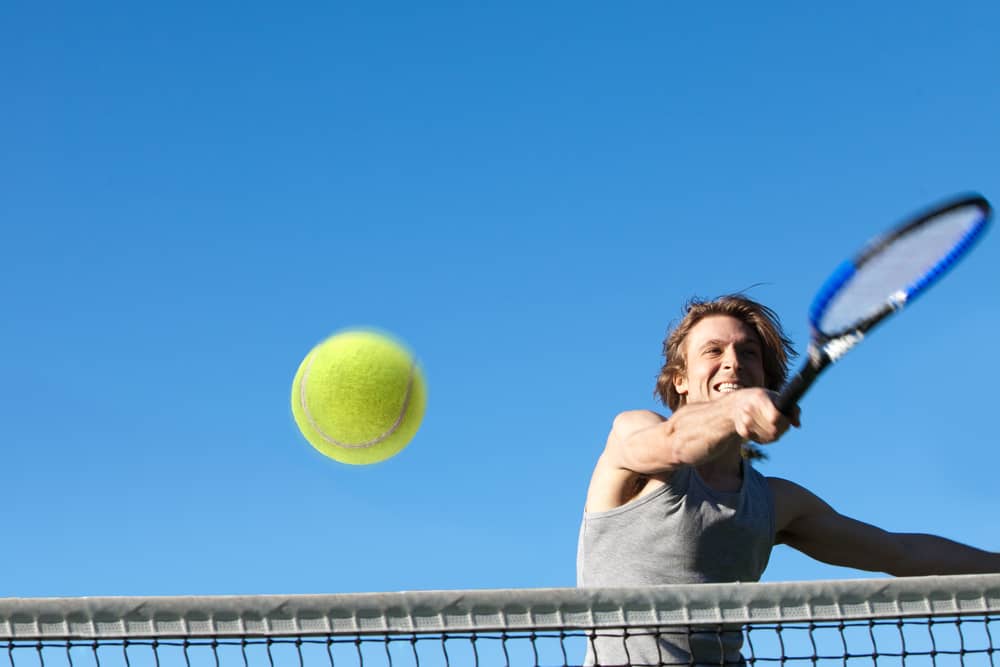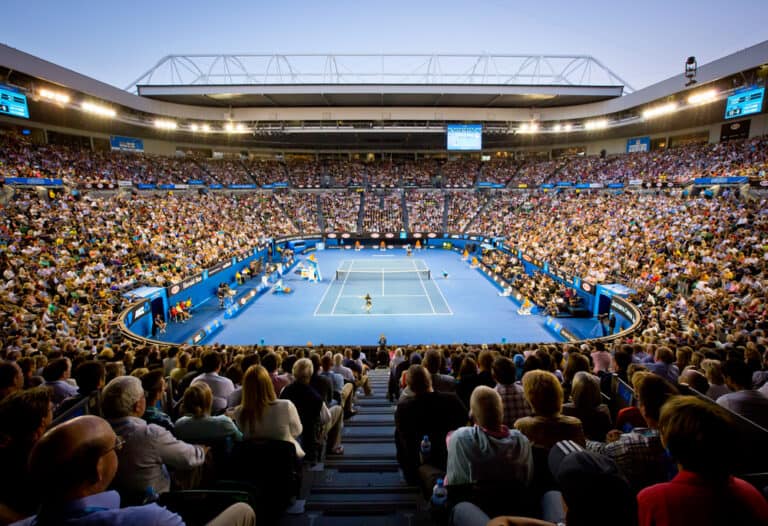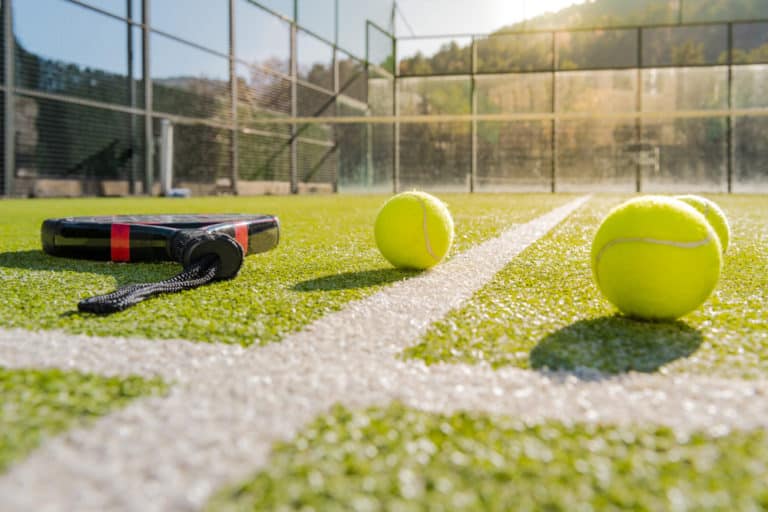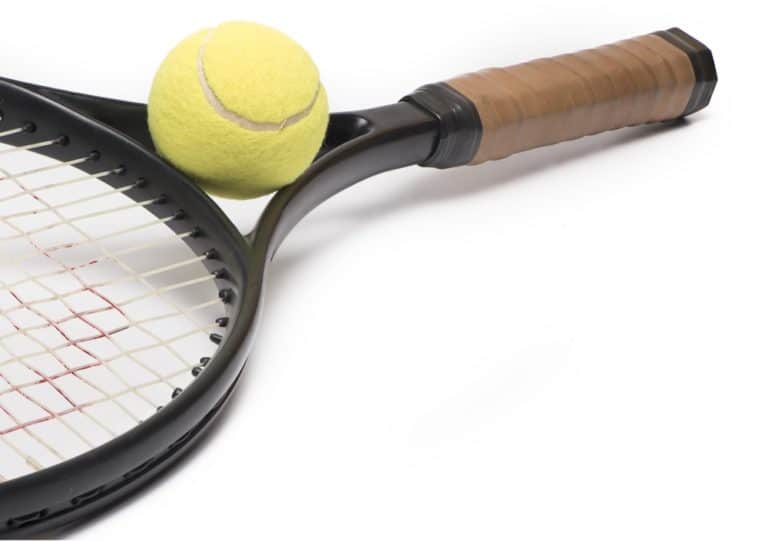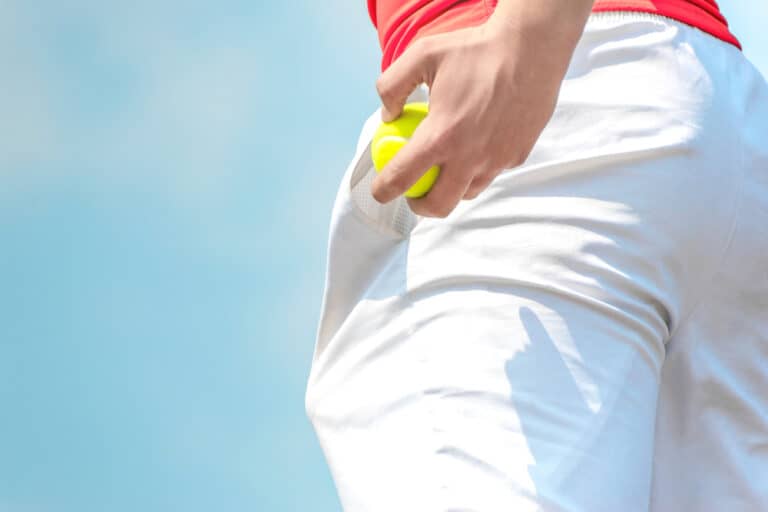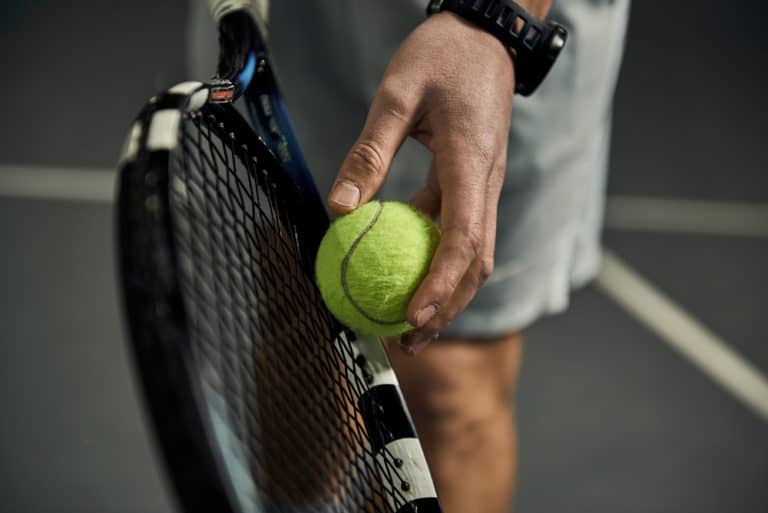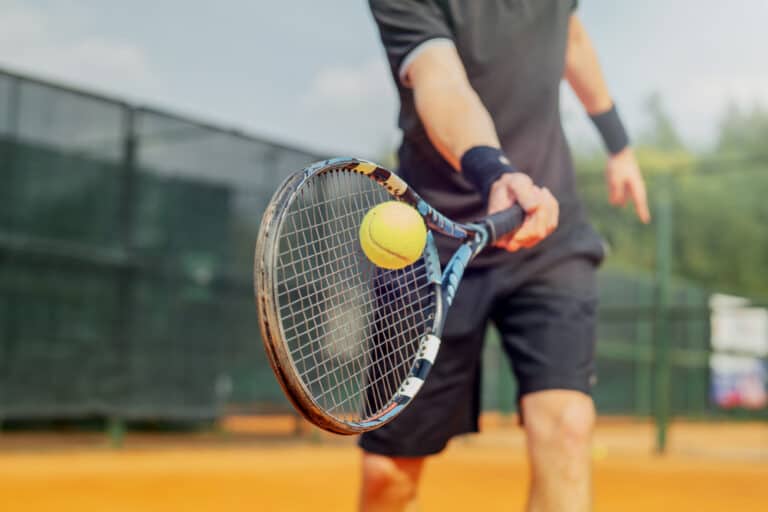When Should You Hit A Tennis Ball?
When I was learning how to play tennis the concept of knowing exactly when to hit the tennis ball was vital in order to improve my level of play. If I hit the ball too early there was a good that I would either hit the wide, long or into the net. The same thing tended to happen if I hit the ball too late. It took me a long time to learn how to hit the ball neither too early nor too late. That is exactly what we will be looking at in this article.
You should hit a tennis ball at the point of the swing where you have maximum racket head speed through the point of impact. Do this by hitting the tennis ball slightly forward of your center of mass so that forward momentum helps generate more power.
Let’s take a closer look at this important skill of learning exactly when to hit a tennis ball so that you can improve the timing of your tennis shots and be able to become a stronger player faster than I was able to do when I was learning how to play tennis.
When Should You Hit A Tennis Ball
If you are a relatively novice tennis player like I am then the optimum time to hit the tennis ball will be as it passes through the apex of its bounce and starts coming down again. That is the point at which the tennis ball will be moving the slowest and give you the most time to get into position properly so that you can time the shot that you want to play.
The trouble with only hitting the tennis ball at the apex of its bounce or as it’s starting to come down again is that your opponent will be more than likely starting to hit high lobs that bounce really high, thereby making it nearly impossible to be able to hit the ball at the apex of its bounce. Waiting until the ball falls from so high makes it a slightly tricky shot for novices to play.
As your tennis skill level improves you can start looking at hitting the tennis ball while it is still on the rise after bouncing. This will bring the tennis ball onto your racket with more speed which allows you to return the ball as a harder shot. Hitting the ball on the rise also allows you to hit the ball earlier meaning that you can return the shot before your opponent has been able to get properly into position and thereby pressure them and potentially cause them to make an error.
I’m not saying that hitting the ball on the rise is the only option for skilled tennis players. If you watch hot top-level tennis players play you’ll notice that they’ll play the ball on the rise if there are in the position to be attacking the ball and putting pressure on the opponent. However, if they are needing to play more defensively then you will notice that they will often play the ball at the apex or indeed past the apex of the bounce as the ball is starting to drop down again.
Therefore, in order to be able to play tennis well you need to have learned how to hit the ball both on the rise and on the fall as well as at the apex of the bounce. Learning all three of these different ways of hitting the ball will help you to become a more rounded tennis player.
Should You Hit The Tennis Ball On The Rise Or Fall?
When deciding to hit the tennis ball on the rise or fall, we first need to take into account where on the tennis court we are standing.
If we are near the net and intend to play a volley, then it will be optimal to hit the tennis ball while it is still on the rise. The reason for this is that if the ball is still on the rise it will be higher than the height of the net making it easier for us to play a flat volley angled downwards with speed over the net. This will make it more difficult for our opponent to return because the ball will be coming back at them so much quicker.
On the other hand, when standing well behind the baseline playing long groundstrokes I have often found it easier to hit the ball while it is on the fall because when I do this I have more time to get in position and can hit the ball harder and the downward momentum will help me to keep the ball from going out over the baseline on the far side of the court.
Hitting the ball on the rise allows you to use the speed of the ball coming onto your tennis racket to generate more power for your shot and the ball goes back to your opponent sooner. This allows you to pressure your opponent increasing the chance that they will make an error on their shot.
Conversely, if you are the player that is out of position on the court then hitting the ball on the fall gives you a bit of additional time to get yourself into position to play your shot.
Should You Always Strike The ball “On The Rise”?
Even though there is a distinct advantage to hitting the ball on the rise, it does not mean that you should always be striking the ball on the rise when playing tennis.
Hitting the ball on the rise means that the ball is carrying more speed onto your tennis racket and you can use that speed to generate additional power for your shot without actually hitting the ball any harder. This allows you to not only play with more power but also means that the ball will be going back to your opponent sooner than they may be expecting.
Therefore hitting the ball on the rise is a way to put pressure on your opponent because the ball is going back to them faster and sooner and they have less time to get into position, creating a greater chance of making an error on their next shot that they attempt to play.
Even though there is this distinct advantage to striking the ball on the rise and you will likely win more points doing so, we need to bear in mind that we have to be in the optimal position on the court to get the maximum benefit from hitting the ball on the rise and exerting pressure on our opponent. For instance, we might be the player that is caught out of position and if so we need time to get ourselves back into position so that we can start taking control of the point again.
Therefore when I have been caught out of position I would allow the ball to bounce beyond the apex and start dropping back toward the ground before I hit the ball. Doing this achieves two objectives. Firstly, letting the ball go through the apex and start dropping means that the ball is moving slower and that makes it a bit easier to hit the ball. The second objective is that letting the ball bounce through its apex and start dropping down means that the ball will be taking longer to get to me, giving me more time to get into position.
While playing you effectively need to ask yourself the question: “am I the player in the advantageous position or am I the player that has been caught out in a suboptimal position and needs to play defensively?”
If you’re playing from the advantageous position then you can exploit your advantage by playing the ball on the rise and putting pressure on your opponent. If you’re the player that is being caught out of position and needs to play defensively, then hitting the ball at or beyond the apex of its flight will give you the time to be able to work yourself back into a more advantageous position and from there you can begin building the point again and start putting pressure on your opponent.
Can You Hit A Tennis Ball Before It Hits The Ground
It is completely within the rules of tennis to be able to hit the ball before it hits the ground. This is called the volley. The only time when you are not permitted to hit the ball before it hits the ground is when you are receiving a service. A service has to hit the ground within the service block before you can play a return of service. That is one instance where hitting the ball before it hits the ground will lose you the point.
If the ball is coming to you and you’re standing behind the baseline and the ball is clearly out, you should not hit the ball before it has bounced. The ball can only be called out after it is bounced outside of the demarcated areas of the court. If the ball is out but hasn’t bounced and you hit the ball the ball will still be technically live and in play. The rally will continue and you have just given your opponent a free pass by putting a ball that was out back in play.
Therefore generally speaking, I will only limit hitting a tennis ball before it bounces to those times when I’m playing near the net and am deliberately playing volleys in a way to be able to put as much pressure on my opponent as I can by getting the ball back to them as quickly as possible.
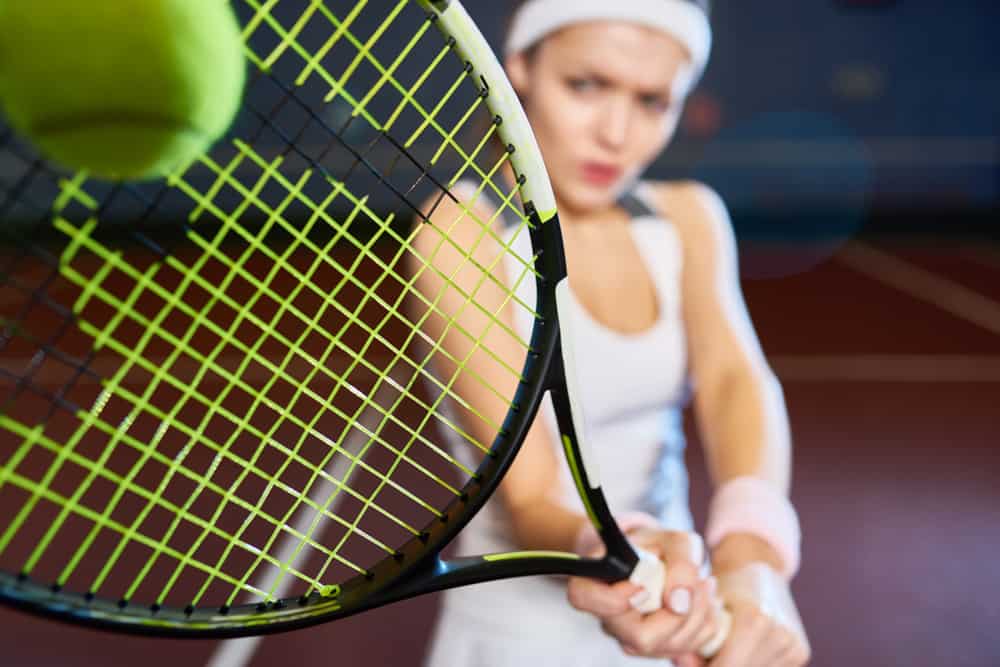
Can You Hit A Tennis Ball Before Crossing The Net
The rules of tennis are very clear with regard to hitting a tennis ball before it has crossed the net. If you are at the net and playing a volley, You need to ensure that the ball has indeed crossed the net before you hit the ball. However, your racket may cross the net after hitting the ball as part of your follow-through.
You need to ensure that neither your racket nor any part of your body touches the net at all or else you will lose the point. Similarly, if you hit your volley before the ball has crossed the net, you will also lose the point.
From this, you can see that the only time you’re allowed to reach over the net during the course of a rally in tennis is after you hit the ball and your racket or maybe your hand crosses the net as part of your follow-through but definitely not before the ball has crossed over to your side of the court.
What Is Timing In Tennis
When I was a junior player my coach would sometimes say that my timing was off when referring to the shots that I was playing and that I needed to spend more time at the practice wall.
The way it was explained to me is that my timing was good when I was able to consistently hit the ball at the fastest part of my tennis swing. My racket head would accelerate during the first part of my swing and decelerate on the follow-through. My objective was always to hit the ball at that special area between the first part of my swing and the beginning of my follow-through.
This is where the concept of timing comes in. Getting the contact point with the ball right at the maximum racket head speed involves starting your swing at the ball at precisely the right moment. I would only be able to start swinging at the ball at precisely the right moment if I had started my backswing at the correct moment in order to have my racket back and ready to play my swing in time to be able to get the racket head to the ball at the right spot.
So even though my coach could see that my timing was off at the point where I was hitting the ball, I needed to work on my backswing as a way to improve my timing rather than trying to rush the shot. My struggle with the timing of my shots was a result of not getting my racket back early enough. The way I got my timing right was through hours of hitting balls at the practice wall until the timing of my backswing became instinctive.
Where Is The Contact Point In Tennis
Mastering the ideal contact point in tennis is a skill that novice players need to learn as they start getting to know how to play the game. The ideal contact point is that point during your swing when your racket’s face is pointing exactly in the direction of where you want to play the ball.
Hitting the ball either before or after that ideal contact point will send the ball either to the left or to the right of where you want to hit it. This can make a big difference when your intended target for the ball to go is on or near the sideline of the court as this can be the difference between your ball going in or out.
Most of the time that same contact point happens to be that point during the swing when the racket head is at its maximum speed.
Where Should You Hit A Tennis Ball?
Every tennis racket has an area that is referred to as the sweet spot. On most tennis rackets this sweet spot will be around the center of the racket face which is the area where the strings both horizontally and vertically work together to be able to produce the maximum power of the shot.
Your objective with every single tennis shot that you play is to hit the ball as close to the sweet spot of your racket as you can.
For me, as a relative novice player, the way I know that I have hit the ball on the sweet spot of my tennis racket is that the shot that I’m playing feels more effortless. If I feel a reverberation of the tennis ball through the racket handle and into my arm then it’s usually an indication that I’ve missed the sweet spot on that particular shot.
I use this type of physical feedback through my racket on each of my shots as a way of helping me to find the sweet spot on my successive tennis shots. That way the more shots that I play the better I become at hitting the ball on the sweet spot of my racket. When I was a kid I would spend hours at the practice wall so that I could get better at hitting the ball on the sweet spot of my racket when playing both with my forehand and my backhand.

